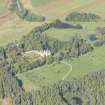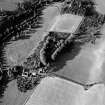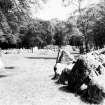Balnuaran Of Clava, Centre
Cup Marked Stone(S) (Neolithic) - (Bronze Age), Ring Cairn (Bronze Age), Stone Circle (Bronze Age)
Site Name Balnuaran Of Clava, Centre
Classification Cup Marked Stone(S) (Neolithic) - (Bronze Age), Ring Cairn (Bronze Age), Stone Circle (Bronze Age)
Alternative Name(s) Clava Cairns
Canmore ID 14277
Site Number NH74SE 3
NGR NH 75713 44433
Datum OSGB36 - NGR
Permalink http://canmore.org.uk/site/14277
First 100 images shown. See the Collections panel (below) for a link to all digital images.
- Council Highland
- Parish Croy And Dalcross (Inverness)
- Former Region Highland
- Former District Inverness
- Former County Inverness-shire
NH74SE 3 7571 4443.
(Centred NH 7571 4443) Stone Circles and Cairns (NR) (Urns containing calcined bones found)
OS 6"map, Inverness-shire, 2nd ed., (1906)
This ring cairn is between the two passage-graves at Balnuaran, the standing stones encircling these sites being only 80 and 123 feet from the monolithic circle of this cairn. All three sites were restored by the owner about 1881 (Jolly 1882).
The kerb of the cairn encloses a slightly oval area measuring 60 by 52 feet. It is built of massive boulders but is now very imperfect on the south side. On the south-south-west opposite the stump of a monolith is the most notable of the kerb-stones, a great rectangular block 4 feet 3 inches high, its neighbouring stones to the west are only 2 feet and 2 feet 10 inches high. The cairn material is heaped up to a height of about 4 feet inside the kerb. Cairn material also extends for about 5 feet outside the kerb as a low grass-grown bank. A small area against the outside of the kerb on the south-south-west side was examined in 1953 but nothing was found except a small patch of charcoal on the old surface.
The central area is defined by a setting of flat slabs (in contrast to the boulders of the kerb, 2 feet 9 inches to 3 feet 6 inches high, which enclose an almost circular space 21 by 18 feet.
The cairn is surrounded by nine monoliths set 25 to 21 feet outside the kerb, with an overall diameter of about 100 feet. The tallest stone remaining is on the west-south- west and is 7 feet 6 inches high. Four of the monoliths, three on the south to south-west arc and one on the east-north-east, were re-erected at the "restoration" (Jolly 1882). Three of the monliths, are connected to the kerb by distinct "causeways" 6 to 8 feet wide and at least 1 foot high. When examined in 1953 they were found to consist of "small boulders carefully packed to form a slightly convex strip" (Piggott 1956). These causeways are a unique feature, there being on trace of them at any Clava-type site.
The monolith on the south-east side is reputed to be cup-marked (Jolly 1882) on it outer side, but it is much weathered and only one cup-marked can now be made out, and that without much confidence. The monolith at the end of the west causeway is also reported as marked, but these are due to weathering. Of the two adjacent cupmarked stones on the east-south-east side of the kerb, one is very weathered and is uncertain, the other is about 3 feet high and is in a leaning position mainly covered with turf. Under the turf can be seen very distinct cup-marks as illustrated (Jolly 1882) except that the channel indicated seems to be a natural crack. Some rough flakes of pebble flint have been found in the central areas (Piggott 1884).
C Innes 1862; W Jolly 1882; J Fraser 1884; S Piggott 1956; A S Henshall 1963, visited 16.4.57
NH 7571 4443 The remains of the ring-cairn are as described above. Revised at 1/2500.
Visited by OS (W D J) 25 April 1962.
Air photographs of the Balnuaran of Clava cairns, taken by Jill Harden in 1989, are in Inverness Museum (8901.21-22 and 8907.02 INVMG). Information from J Harden 1989.
Field Visit (July 1979)
Balnuaran of Clava, Centre (INV 8), NH 757 444 NH54SE 3
A Clava ring-cairn within a circle of nine standing stones, of which three are linked by 'causeways' to the platform of stones that extends outwards from the kerb of the cairn for about 1.5m. The cairn measures 18.3m by 15.9m over a kerb of graded boulders to enclose a central area 6.5m by 5.5m. One of the standing stones and two of the kerb-stones are cup-marked.
RCAHMS 1979, visited July 1979
(Piggott 1956, 192; Henshall 1963-72, i, 361-6; Ritchie and Maclaren 1972, 8)
Excavation (1994)
NH74SE 4 (SW cairn) and central cairn: The 1994 excavation at Balnuaran of Clava had three main aims. First, it sought to identify how far the site has changed its appearance as a result of modem restoration of the monument. A main focus was the largely unpublished excavation of 1930-31. Two of these trenches were reopened and other work was carried out on the SW passage grave. This showed that the chamber 'floor' identified in that work was in fact the old land surface beneath the monument. Both there and at the central ring caim excavation had extended into the natural fluvio-giacial gravel, In the case of the central ring cairn unrecorded excavation around the end of the last century had resulted in the clearance of the interior. The rubble removed from that part of the site was added to the material of the cairn.
Second, it sought to resolve the structural sequence at both monuments. At the SW cairn the external ramp was of a single phase. It had been built simultaneously with the kerbstones, which lacked any sockets. At the central ring cairn, there is evidence that the cairn, the stone circle and the external rays which connect these features together were all built at the same time. The line of at least one of the rays seems to have perpetuated division in the internal construction of the ring cairn. In between its kerb and the circle of monoliths was a setting of flat slabs overlying an unaccompanied cremation- This formed the focus for a distribution of pieces of worked flint and quartz.
Third, it aimed to obtain radiocarbon samples. Four such samples were collected, from the old land surfaces beneath each of the cairns, from the cremation outside the central ring cairn and from the socket of one of the monoliths enclosing that site.
Sponsors: Society of Antiquaries of Scotland, British Academy, Society of Antiquaries of London, with considerable help in kind from Historic Scotland, Highland Regional Council and Reading University.
Bradley 1994.
Watching Brief (18 December 2012)
NH 7571 4443 A watching brief was undertaken, 18 December 2012, during the excavation of small trenches to allow the installation of permanent survey markers. The 11 holes excavated did not exceed a depth of 200mm and no features of archaeological significance were recorded.
Archive: RCAHMS (intended)
Funder: Historic Scotland
Thorsten Hanke, Kirkdale Archaeology, 2013
(Source: DES)
OASIS Id: kirkdale1-311423
Watching Brief (22 February 2018)
A watching brief was carried out by CFA Archaeology Ltd within the Scheduled Monument of Clava Cairns, Highland. A tree bole from a fallen tree was cleaned by hand and inspected prior to removal of the tree by a tree surgeon. No features, deposits or artefacts of archaeological significance were identified.
Information from CFA Archaeology Ltd.
Field Visit (November 2019)
NH 75734 44402 (centred) Visitor numbers to Balnuaran of Clava Cairns have increased year-on-year but especially within the last five years. This has created its own problems with damage and erosion being caused to the archaeological sites within the Property in Care boundary.
An erosion survey was carried out, in November 2019, within the environs of Balnuaran of Clava Cairns to look at the general condition and state of erosion suffered to the archaeological sites. The survey revealed that the monuments are suffering from various degrees of erosion ranging from intrusive to, in many cases, severe. The main cause for the erosion is visitor footfall, not only to the monuments themselves but to the roots of the surrounding tree cover.
The survey also noted the eastern half of a rectangular stone-built feature beginning to erode out of the grass between Cairn 3 and 2. The feature also appears on a recent LIDAR survey of Balnuaran of Clava Cairns as either two joined squares or a rectangular feature with a dividing wall.
Archive: NRHE (intended)
Funder: Historic Environment Scotland
Graeme Carruthers − CFA Archaeology Ltd
(Source: DES Vol 21)
Note
Date fieldwork started: 04/07/2019
Compiled by: NOSAS
Balnuarin of Clava Centre Kerb 3
Scotland's Rock Art Project ID: 3090
Location notes: This panel is part of the complex of monuments at Clava ('Clava cairns'), well known and much frequented by visitors. There is a car park and interpretation. It is located on a level river terrace to the SE of the river Nairn, in the flat bottom of the SW to NE valley. This is one of the kerbstones of the central cairn. It stands to the SE of the centre of the cairn, and in a clockwise direction is the last before a gap in the stones present today.
Panel notes: This panel is a rounded boulder of gneiss, set upright and about 0.9m high x 0.9m broad x 0.5 m thick. The carved surface faces to the SE towards the cup marked gneiss orthostat associated with this cairn. The single cup is shallow but smooth and distinct in the relatively rough surface of the rock.
Note
Date fieldwork started: 11/06/2019
Compiled by: NOSAS
Balnuarin of Clava Centre Centre
Scotland's Rock Art Project ID: 3197
Location notes: This panel is part of the complex of monuments at Clava ('Clava cairns'), well known and much frequented by visitors. There is a car park and interpretation. It is located on a level river terrace to the SE of the river Nairn, in the flat bottom of the SW to NE valley. It is an inner kerbstone in the wall of the chamber of the central ring cairn, SW of the centre.
Panel notes: This panel is one of the inner kerbstones of the central chamber of the central cairn at Clava. It is recorded (The Good Stones: A New Investigation of the Clava Cairns, Richard Bradley, Society of Antiquaries of Scotland Monograph Series Number 17, Edinburgh 2000 illus 14 p20) as having a single cup. No sketch is provided, and it is possible that any cup is below the present ground level. On physical examination none was visible, but the surface of the stone shows signs of having been worked. Photogrammetry reveals several possible cups, none very convincing.
Note
Date fieldwork started: 11/08/2018
Compiled by: ScRAP
Balnuarin of Clava Centre Kerb 1
Scotland's Rock Art Project ID: 3097
Location notes: The panel is part of the complex of monuments at Clava ('Clava cairns'), which is well known and much frequented by visitors. There is both a car park and on site interpretation. The site is located on a level river terrace to the SE of the river Nairn, in the flat bottom of the SW to NE valley. This panel is one of the kerbstones of the central cairn: it can be found on the E edge and is immediately to the right of another carved panel, Clava Centre Kerb 2. Both panels are recorded as a part of the Balnuarn of Clava, Centre, ring cairn and stone circle (Canmore ID:14277).
Panel notes: Approximately 1.1m in height, this panel is a kerbstone which leans towards the centre of the Balnuarn Of Clava, Centre, ring cairn and stone circle monument (Canmore ID:14277). This panel is at the inner end of one of the 'rays' which lead out to a standing stone. The surface of the panel is smooth and the cupmarks are indistinct: there are possibly 8 motifs in total. Richard Bradley (The Good Stones - A New Investigation of the Clava Cairns. Society of Antiquaries of Scotland 2000. Illustration p45, stone G) shows 12 cups, of which 4 would be below the current ground surface.
Note
Date fieldwork started: 08/11/2018
Compiled by: ScRAP
Balnuarin of Clava Centre Kerb 2
Scotland's Rock Art Project ID: 3098
Location notes: The panel is part of the complex of monuments at Clava ('Clava cairns'), well known and much frequented by visitors. There is both a car park and on site interpretation. The site is located on a level river terrace to the SE of the river Nairn, in the flat bottom of the SW to NE valley. This panel is one of the kerbstones of the central cairn on the E edge of the monument and can be found immediately to the left of another panel recorded as Clava Centre Kerb 1. Both panels have been recorded as a part of the Balnuaran of Clava, Centre, Ring Cairn and Stone Circle monument (Canmore ID: 14277).
Panel notes: Approximately 0.9m in height and 0.9m in width, this panel is an outer kerbstone of the Balnuaran of Clava, centre, ring cairn and stone circle (Canmore ID: 14277). The panel can be found at the inner end of one of the 'rays' which lead out to a standing stone. The surface of the panel is smooth with some possible markings, but no cups marks could be detected. Richard Bradley (The Good Stones - A New Investigation of the Clava Cairns. Society of Antiquaries of Scotland 2000. Illustration p45, stone F) previously recorded 6 cupmarks.
Note
Date fieldwork started: 11/06/2019
Compiled by: NOSAS
Balnuarin of Clava Centre Orthostat 1
Scotland's Rock Art Project ID: 3198
Location notes: This panel is part of the complex of monuments at Clava ('Clava cairns'), well known and much frequented by visitors. There is a car park and interpretation. It is located on a level river terrace to the SE of the river Nairn, in the flat bottom of the SW to NE valley. It is one of a ring of orthostats around the central ring cairn (Balnuaran of Clava Centre) and about 15m SE of its centre.
Panel notes: This standing stone is one of a ring of stones surrounding the central cairn at Clava. It is a pointed slab of gneiss, 1.8m high x 1.6m wide x 0.8m thick. The outer face has a single distinct cup and 3 much fainter possible ones. The inner face (towards the cairn) has one probable cup. Richard Bradley (The Good Stones: A New Investigation of the Clava Cairns, Richard Bradley, Society of Antiquaries of Scotland Monograph Series Number 17, Edinburgh 2000 illus 14 p20) records a single cup mark on each face.














































































































































































































